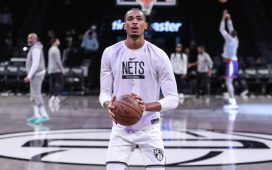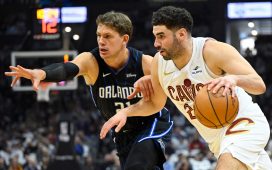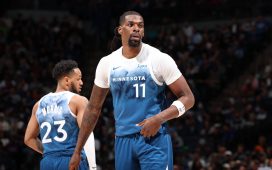Want more basketball in your inbox? Sign up for Marc Stein’s weekly N.B.A. newsletter here.
The Nets’ superstar Kevin Durant will soon grow by two to three inches, while Kemba Walker of the Boston Celtics, J.J. Barea of the Dallas Mavericks and others are likely to shrink by a similar amount.
The listed heights of N.B.A. players have long been widely considered more art than science, but the league notified teams this week that they are required to certify and submit each player’s height and age within the first week of training camp, according to four people familiar with the new policy.
Sparked by the league’s determination to emphasize “the integrity of information” it disseminates publicly, front offices were informed that player heights must be certified by a team physician and their ages confirmed via the submission to the league office of a driver’s license or passport, according to the people, who were not authorized to discuss the procedural changes publicly.
Among the motivations for the crackdown is the case of the Sacramento Kings’ Buddy Hield, whose age was discovered in December 2018 to have been recorded incorrectly.
Hield revealed on December 17 — his birthday — that he was had just turned 26, not 25 as was widely listed. But he insisted he had never lied and that websites simply had gotten the year wrong.
The new rule is designed to clear up such discrepancies.
“A consistent process has been created to ensure the integrity and accuracy of the data on team rosters,” Mike Bass, a spokesman for the N.B.A., said on Thursday.
In a June interview with Bloomberg, the N.B.A.’s deputy commissioner, Mark Tatum, said that the league’s fans and business partners would question the N.B.A.’s transparency if it could not guarantee the accuracy of publicly disclosed data as routine as heights and ages.
“In this new world that we’re living in, the integrity of that information is critical,” Tatum told Bloomberg. “That’s knowable information, and it’s something that we are looking at. The standards now, in a legalized sports betting world, are going to be much, much higher than they ever have been.”
Biographical information about N.B.A. players historically has been rife with inaccuracies. Some players, like the Hall of Famer Charles Barkley (6 feet 6 inches) and Golden State’s Draymond Green (6-foot-7), have been routinely listed at heights that are presumably inflated to counter suggestions that they are too small for their positions. The sizes of some smaller guards, like Walker (6-foot-1), Barea (6 feet) and the Hall of Famer Allen Iverson (6 feet), are also assumed to have been inflated.
Others such as the retired trio of 6-foot-11 stars Kevin Garnett, Tim Duncan and Bill Walton — as well as the Nets’ 6-foot-9 Durant — have insisted on being listed as shorter than they really are to avoid being pigeonholed as a 7-foot power player.
In 2016, when Durant was joined by DeMarcus Cousins on the United States men’s basketball team for the Rio Olympics, Cousins openly joked with reporters about how their proximity was exposing both for having been untruthful about their heights.
“I keep telling him to stop standing by me, man,” Cousins said to a reporter for SNY.tv. “I think people are starting to figure out, I might be about 6-7. He’s every bit of 7 feet, every bit.”
Durant explained the situation to The Wall Street Journal, saying: “For me, when I’m talking to women, I’m 7 feet. In basketball circles, I’m 6-9. But really, I’ve always thought it was cool to say I’m a 6-9 small forward. Really, that’s the prototypical size for a small forward. Anything taller than that and they’ll start saying, ‘Ah, he’s a power forward.’ ”
Kent Wipf, Minnesota’s former longtime public relations director, posted on Twitter on Thursday that Garnett was “well over” 7 feet tall “but never wanted to be listed above 6-11” because “they would want to make him play center.”
“I always wanted to list him at 6-13 but I was not allowed,” Wipf wrote.
Exaggerated heights are commonplace in high school and college basketball as well, as players have long sought to make themselves more appealing to scouts at the next level. N.B.A. teams have likewise frequently recycled the data from players’ college careers, but the new policy mandates that players will be measured by team doctors without wearing shoes — as seen at the league’s annual draft combine.
Durant, for example, was measured at 6-foot-9 without shoes at the draft combine in 2007, when he was a 19-year-old leaving the University of Texas for the pros after just one collegiate season.
Players added to a team’s roster during training camp or the regular season will also have to be measured under those guidelines within a week of signing. The league, however, is not insisting on team-certified weight listings because weight can so easily fluctuate, according to one person briefed on the new guidelines but not authorized to discuss them publicly.
“We have to have a standard measurement, where everybody stands there without shoes, back straight,” Tatum told Bloomberg in June.
In another recent measure adopted in the name of transparency — but which has also been interpreted as a concession to gamblers — the N.B.A. announced last week that teams would be required to announce their starting lineups at least 30 minutes before the opening tip. The previous requirement was 10 minutes before tipoff.








